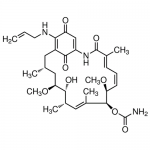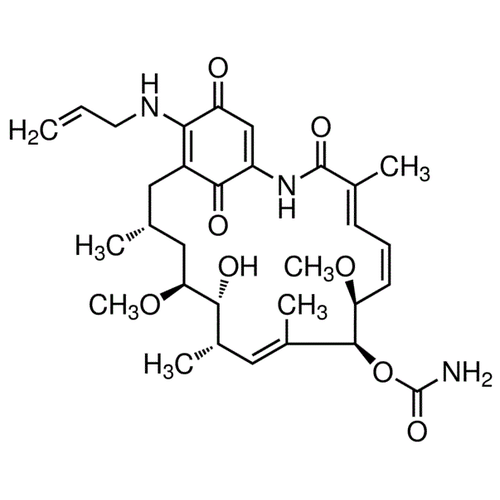| Product Name | 17-AAG |
| Description |
Hsp90 inhibitor |
| Purity | >99% (HPLC); NMR (Conforms) |
| CAS No. | 75747-14-7 |
| Molecular Formula | C31H43N3O8 |
| Molecular Weight | 585.7 |
| Field of Use | Not for use in humans. Not for use in diagnostics or therapeutics. For in vitro research use only. |
Properties
| Storage Temperature | -20ºC |
| Shipping Temperature | Shipped Ambient |
| Product Type | Inhibitor |
| Solubility | Soluble in DMSO (>50 mg/ml) or ethanol (5 mg/ml) |
| Source | Synthetic |
| Appearance | Red to dark red powder |
| SMILES | C[C@H]1C[C@@H]([C@@H]([C@H](/C=C(/[C@@H]([C@H](/C=CC=C(C(=O)NC2=CC(=O)C(=C(C1)C2=O)NCC=C)/C)OC)OC(=O)N)C)C)O)OC |
| InChI | InChI=1S/C31H43N3O8/c1-8-12-33-26-21-13-17(2)14-25(41-7)27(36)19(4)15-20(5)29(42-31(32)39)24(40-6)11-9-10-18(3)30 |
| InChIKey | AYUNIORJHRXIBJ-TXHRRWQRSA-N |
| Safety Phrases |
Classification: Caution: Substance not yet fully tested. Safety Phrases: S22 - Do not breathe dust S24/25 - Avoid contact with skin and eyes S36/37/39 - Wear suitable protective clothing, gloves and eye/face protection |
| Cite This Product | 17-AAG (StressMarq Biosciences Inc., Victoria BC CANADA, Catalog # SIH-100) |
Biological Description
| Alternative Names | 17-(Allylamino)-17-demethoxygeldanamycin, 17-(Allylamino)geldanamycin, 17-Demethoxy-17-allylamino geldanamycin, 17-AAG, CP 127374, Geldanamycin,17-demethoxy-17-(2-propenylamino)-, NSC 330507, Tanespimycin |
| Research Areas | Cancer, Heat Shock |
| PubChem ID | 6505803 |
| Scientific Background | Glendanamycin (GA), a benzoquinone ansamycin antibiotic, interferes with the action of Hsp90 leading to degradation of Hsp90 client proteins. GA itself however has undesirable properties such as poor aqueous solubility and liver toxicity; therefore, numerous analogs have been synthesized, such as 17-AAG(1). 17-AAG is an HSP-90 inhibitor that displays a 100-fold higher affinity for HSP-90 derived from tumor cells compared to HSP-90 from normal cells(2). 17-AAG inhibits Akt activation and expression in tumors and synergizes with a number of antitumor agents such as taxol(3), cisplatin(4) and UCN-01 (400 nM 17-AAG, U937 cells)(5). It has also been found that 17-AAG is alo an effective inducer fo the autophagic pathway by which alpha synuclein can be removed. It may provide a means to modulate autophagy in neural cells (6). |
| References |
1. Neckers L. (2002) Trends Mol Med. 84: S55-61. 2. Kamal A., et al.(2003) Nature. 425: 407. 3. Solit D.B., et al.(2003) Cancer Res. 63: 2139. 4. Vasilevskaya I.A., et al. (2003) Mol.Pharmacol. 65: 235. 5. Jia W., et al.(2003) Blood. 102: 1824. 6. Riedel M., Goldbaum O., Schwarz L., Schmitt S., Richter-Landsberg C. (2010) PLOS ONE. 5(1): e8753. https://doi.org/10.1371/journal.pone.0008753 |



Reviews
There are no reviews yet.